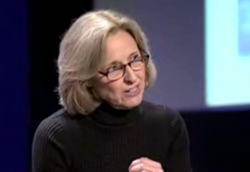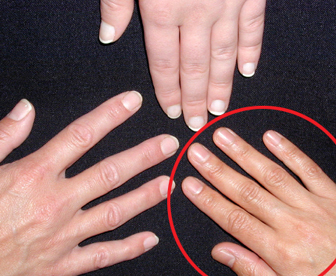
I recently spoke to biological anthropologist Dr. Helen Fisher about her groundbreaking work on the chemical basis of our personality and its influence on who we fall in love with. As it turns out, science can shed a lot of light on a topic previously dominated by doubt, horoscopes, and what our mama told us.
“So have you read the book?” asked Fisher. “What ‘type’ are you?”
“Explorer/Negotiator. Are you sizing me up according to my ‘type’ now?” I teased.
“No,” Fisher replied; “But I had a bad experience with a journalist once. A Builder. I gave her broad theories, but what she wanted was the concrete facts. After that, I figured I’ve got all of this data about people’s personality, so I might as well use it to give them what they want!”
These “types” are shorthand for a constellation of personality traits that emerge in response to certain biological and neurotransmitter activity. The link between our chemicals and our innate personality is the basis of Dr. Fisher’s new book, Why Him? Why Her? By knowing your place on Dr. Fisher’s scale, you can spot trends in your love life or streamline your search for new romance.
It is tempting to discuss the research in the language of more superficial quizzes, but Dr. Fisher’s measure is not the multiple-choice page at the back of Seventeen that tells you whether your “type” is a “bad boy” (“There is a big difference!” Dr. Fisher chided.) This questionnaire focuses on determining pertinent aspects of the temperament through four chemical systems linked to love. Your most dominant activity suggests your “type”:
Explorers, characterized by novelty-seeking, are linked to the dopamine system.
Builders, characterized by straightforwardness and stability, are linked to the seratonin system.
Directors, characterized by decisiveness and focus, are linked to the testosterone system.
Negotiators, characterized by web-thinking and verbal skills, are linked to the estrogen system.
In a sample of 28,000 people, the population was split fairly evenly between the four “types”. More excitingly, the types showed strong and predictable preferences when it comes to attraction. “And then I have my charts in which I show that explorers are drawn to explorers, and builders to builders, and directors for negotiators and negotiators for directors.” So it’s true: opposites attract AND birds of a feather flock together.
The benefit of this scale over even respected personality-typing tools such as the Myers-Briggs Type Indicator is that Dr. Fisher’s work establishes a biological, causal relationship. The veracity of this relationship has been carefully scrutinized in Dr. Fisher’s academic work. “When you create a new measure, as they call it, you have to create reliability and validation.”
“Reliability means that all of your questions have to kind of stick together. If the explorer IS open to new experiences, curious, creative, then they also have to respond to other questions in that scale that indicate that the questions go together.”
Curious? Take the questionnaire at whyhimwhyher.com and you will notice a certain thematic quality to each page of questions. It’s easy to see how they go together to suggest a set of related personality traits. The design side of a questionnaire is not as straightforward.
Dr. Fisher recounted this example. “I asked a question: Do you find the right word rapidly? And I expected my negotiators to all say yes, and the other types to say no. It’s associated with the estrogen system. It’s very, very clear data-- estrogen is associated with basic articulation, which is finding the right word rapidly. And, sure enough, that question didn’t work! It didn’t work because explorers also said they find the right word rapidly. Well, guess what. Explorers find A word rapidly, haha! But not necessarily the RIGHT word.”
That question was removed. “If you get a question that doesn’t differentiate each type, you’ve got to take it out and put another one in until you find questions that do.”
And the validation? “THEN what you’ve got to do is prove that what you SAY you’re studying you really are studying. For example, that’s why I have the question about the hand.”
Studies have shown that a high length ratio of the 4th (ring) to the 2nd (index) finger, determined by prenatal testosterone exposure, positively correlates to testosterone-related traits later in life. “And as it turned out, people who measured very high on the director’s scale also had a much longer 4th finger.” Unsurprisingly, those who measured high on the estrogen scale showed longer index fingers. A panoply of similar markers were explored in order to tether the identity of Fisher’s Explorers to dopamine activity and Builders to seratonin.

The results of your temperament aren’t limited to your love preferences. Dr. Fisher has been working with Chemistry.com to correlate other facets of life to one’s dominant scale. “What does each type eat for breakfast? How does each type exercise?” But perhaps the most valuable information that Dr. Fisher’s scales give us is a glimpse into the minds of the people around us.
“I have a wonderful friend-- he’s a basic scientist, and he called me up after having read the book. There was a long pause on the phone. And he said: I finally understand my son. I think that you can understand your children, you can understand your friends, you can understand your business partners, I think you can understand world politics better.”
Dr. Fisher may well have known, then, that if a Builder journalist was interested in the raw data, this Explorer was far more interested in what Dr. Fisher is going to do next.
“You know, I’ve been trying to avoid that question. I don’t really know!” Not surprisingly, Dr. Fisher is interested in using her personality measure to explore more more Big Questions. “I really want to know how these types play out in long-term relationships. I really want to know what kind of marriage two explorers make, a builder and an explorer make, a builder and negotiator make.”
Going even further: “What really interests me personally is looking at history.” Past and present political figures such as the Obamas, the Bushes and the McCains are frequently viewed through the lens of Fisher’s scale in Why Him? Why Her?. “Bill and Hillary Clinton. A very interesting marriage, the negotiator and the director. I know these are only single samples, I’d need to collect broad data on couples in history. And understand even more about these types. I really am fascinated by this stuff!”
It’s hard not to be. Transitioning from a descriptive model of romance into a predictive tool is a bold, exciting step. For that matter, Dr. Fisher’s is the only science-related book that has offered me advice on how to flirt effectively. Why Him? Why Her? is compelling Valentine’s reading for the science enthusiast and the romantic alike.



Comments